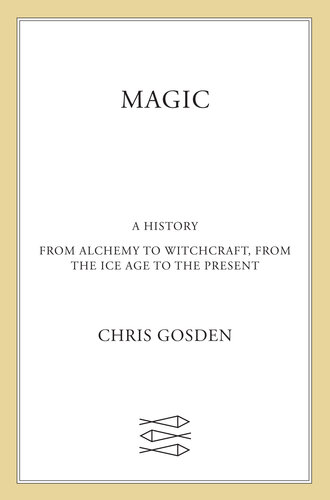
Magic: A History
From Alchemy to Witchcraft, from the Ice Age to the Present
کتاب های مرتبط
- اطلاعات
- نقد و بررسی
- دیدگاه کاربران
نقد و بررسی

May 18, 2020
Oxford University archaeology professor Gosden (Prehistory: A Very Short Introduction) delivers a sophisticated and wide-ranging study of the role of magic in human history. He explores the differences between magic, religion, and science as methods of facilitating human communication with the universe, and examines prehistoric cave art; the complex dynamic between magic and miracles in Jewish, Greek, and Roman settlements between 1000 BCE and 1000 CE; the role of gods and divination in Mesopotamia; Chinese beliefs in a portal between the worlds of the living and the dead that could be used to obtain help from deceased ancestors; and the development of shamanism in the Eurasian steppe. European societies have practiced many forms of magic throughout history, according to Gosden, including astrology, the symbolic placement of artifacts on the landscape (Stonehenge), and the transformation and creation of potent objects. Gosden also explores the use of magic in colonized Africa, Australia, and the Americas, and looks at how spiritualism, the Wiccan movement, and the growing importance of ecology have become important expressions of magic since the 19th century. Though dense and scholarly, Gosden’s meticulous account offers many intriguing glimpses of early human societies. Readers with a deep interest in human belief systems will be captivated.

September 1, 2020
In this expansive history of magic in the ancient world, archaeology professor Gosden makes the case for the ongoing centrality of magical thought and practice to the human experience. Contrary to magic's poor reputation in the modern world, Gosden argues that it must be considered alongside science and religion as a major strand of belief throughout history. Magic begins with the earliest archaeological evidence of human habitation, then teases out the differences and similarities among magical practices in the deserts of Egypt, the Siberian steppe, Chinese hill country, and many more. In all of these disparate places and cultures, however, we find a shared desire to understand how humans affect and are affected by the world we live in, whether that understanding comes from science, religion, or magic. At times the book's ambition is more hindrance than help, as Gosden bewilderingly dedicates a single chapter to three continents while electing not to discuss South Asian magic at all. Despite such gaps in the story, Magic is an authoritative history of humanity's engagement with the supernatural.(Reprinted with permission of Booklist, copyright 2020, American Library Association.)

Starred review from October 1, 2020
Godson's (Prehistory: A Very Short Introduction) enlightening history explores magical beliefs and practices in cultures around the world from the earliest ages of human history, drawing on evidence from archaeological and textual sources. Defining magic as practices seeking to explore and exploit the connections between humans and the world around them, Godson identifies participation as the hallmark of magical traditions. Cave paintings, grave goods, protective amulets, and graffiti etched into church walls are some of the many examples of magical artifacts Godson uses to illustrate the ways in which different cultures have sought to understand the place of human beings within the cosmos and to harness the power of correspondences to foretell or influence future events. Rather than forming successive trends of increasing rationality, Godson persuasively argues that magic, religion, and science have always existed in tandem, forming a "triple helix" of understanding running through the course of human history up to the present day. In light of the current climate crisis, and inspired by the discoveries of quantum physics, Godson furthermore makes a compelling case for a return to the kind of interconnected perspective central to most magical traditions. VERDICT A fascinating exploration of magic's hold on the human imagination.--Sara Shreve, Newton, KS
Copyright 2020 Library Journal, LLC Used with permission.

























دیدگاه کاربران